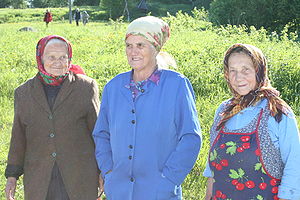Karelians

The Karelians is a name used to denote two related groups of Finnic-language speakers. The so called "Russian Karelians" inhabit the Russian Republic of Karelia. The "Finnish Karelians" live in eastern Finland.[1][2][3][4] The use of the name Karelians of both groups sometimes causes confusion. During the Second World War many Finnish Karelians were forced to leave the Karelian provinces that Finland had to cede to the Soviet Union. They and their descendants are now integrated in the population of present-day Finland.
At least since the 13th century, the two groups have had different histories, cultures, religions, identities and dialects. They are usually thought as members of two closely related but clearly distinct ethnic groups speaking different languages. Earlier, the Russian Karelians were often considered as Finns especially by Finnish nationalists.
History
Since the 13th century the Karelians have lived in the tension between the East and the West, between Eastern Orthodoxy and Western Catholicism, later Lutheranism. Some Karelians were christianized and subdued by Sweden, others by Novgorod or Russia. Thus Karelia was split into two different and often hostile groups. The Kingdom of Sweden held Western Karelia and Karelian Isthmus but Central, Northern and Eastern Karelia were under the Russian rule. In the 17th century the tension between the Lutheran Swedish government and Orthodox Karelians triggered a mass migration from Swedish Karelia into the region of Tver in Russia, forming the Tver-Karelian minority. People from Savonia moved to Karelia in large numbers.
By 19th century the cultural and lingual differences between Finns and Karelians were so thin that several linguists including Elias Lönrot went of Central and Eastern Karelia to gather folklore that Finns seemed to have partially lost by that time. Since that time however the differences seem to have grown as Finns boosted their identity whereas the East Karelians were struggling to preserve their cultural and lingual heritage.
When Finland gained its independence in 1917 only a small fraction of the Orthodox Karelians lived in the Finnish Karelia. The lands were mainly populated by Finnish Karelians of Lutheran background. Finland lost most of this area to the Soviet Union in World War II, when over 400,000 people were evacuated over Finland's new border from the Karelian Isthmus, Ladoga Karelia and, to a lesser degree, from the main part of East Karelia that had been held by Finland 1941–1944.
The Finnish Karelians are Finns. The main dialectical division among the Finns, that between the East Finnish and West Finnish dialects, defines the Savonians and the Finnish Karelians as East Finnish.
The Russian Karelians, living in the Republic of Karelia, are nowadays rapidly being absorbed into the Russian population. This process began several decades ago. For example, it has been estimated that even between the 1959 and 1970 Soviet censuses, nearly 30 percent of those who were enumerated as Karelian by self-identification in 1959 changed their self-identification to Russian 11 years later.[5]
Many of the evacuees have emigrated, mainly to Sweden, to Australia and to North America. A large share of the over 70,000 Finnish war children that were evacuated from Finland, chiefly to Sweden and Denmark, came from Karelian families that had lost their homes due to the Winter War. A fifth of these children remained abroad and many more re-emigrated later.
Language
The Karelian language is closely related to the Finnish language, and particularly by Finnish linguists seen as a dialect of Finnish, although the variety spoken in East Karelia is usually seen as a proper language. [1]
The dialect spoken in the South Karelian region of Finland belongs to the South Eastern dialects of the Finnish language. The dialect spoken in the Karelian Isthmus before World War II and the Ingrian dialect were also part of this dialect group.[2] The dialect that is spoken in North Karelia is considered to be one of the Savonian dialects.[3]
Religion
The Russian Karelians are Eastern Orthodox Christians. Most Finnish Karelians are Lutherans.
Demographics
Significant enclaves of Karelians exist in the Tver oblast of Russia, resettled after Russia's defeat in 1617 against Sweden — in order to escape the peril of forced conversion to Lutheranism in Swedish Karelia and because the Russians promised tax deductions the Orthodox Karelians mass migrated there. Olonets is the only city in Russia where the Karelians form a majority (60% of the population).
Culture
The Karelian culture and language was a major inspiration for the Fennoman movement, and the unification of East Karelia with independent Finland (Greater Finland) was a major political issue in 20th century Finland.
References
- ^ Suomen kaakkoisrajan muutoksia
- ^ Karjalan heimo syntyy
- ^ Karjala - kieli, murre ja paikka
- ^ Mauri Rastas: "History of Karelia"
- ^ Barbara A. Anderson and Brian D. Silver, "Estimating Russification of Ethnic Identity among Non-Russians in the USSR," Demography 20 (November, 1983): 461-489.
See also
External links
- Russian Karelians (The Peoples of the Red Book)
- Many Karelias (Official Virtual Finland page)
